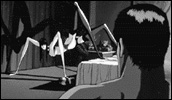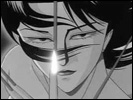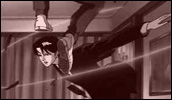Wicked City
- Year
- 1987
- Original title
- Yoju Toshi
- Japanese title
- 妖獣都市
- Director
- Cast
- Running time
- 80 minutes
- Published
- 7 March 2006



by Jasper Sharp
Wicked City is a fascinating title to revisit for those interested in the evolution of Japanese animation. For starters it represents the conjunction and culmination of several strains of 1980s fantasy cinema: the visceral force of the gruesome demonic body-horror splatter movies typified by Sam Raimi's Evil Dead (1981) and Italian imitations like Lamberto Bava's Demons (1985); a bleak futuristic setting indebted to the sci-fi noir sub-genre initiated by Ridley Scott's Blade Runner (1982); the morbid sexual imagery of the modern vampire myth mapped out in films like Tony Scott's The Hunger (1982), all laced heavily with an extremely vicious form of eroticism of the entirely home-grown variety - the rape and rope fetishes of late-period Nikkatsu Roman Porno. Phallic tentacles sprout from chests plunging into flesh, bodies twist and split in two, heads fly off, and eyeballs explode from their sockets. In an early scene, a raven-haired temptress picked up casually from a bar writhes in post-coital bliss, her limbs elongating and entwining her victim as she assumes the form of a spider before they part to reveal a Venus Flytrap-like vulva arrayed with fangs, the overt manifestation of Freud's most deep-rooted and primal male fear, the vagina dentata. They certainly don't make them like this any more, and certainly not as feature-length cartoons...
Wicked City is also a fascinating example of anime's near-obsessive pursuit of cinematic realism to portray something that, in the pre-CG era at least, would have been impossible to render in live-action, and even if it could, would have been far too graphic to slip by the censors. This blurring of the boundaries between animation and live-action cinema appeared to be the guiding principle of a generation of animators who made their names in the 80s, and was well underway by the time of the landmark productions of Wings of Honneamise and Akira that first opened the eyes of foreign audiences to this radically different usage of the animated medium.
If foreigners were first attracted to "Japanimation" by this latter aspect, then they took a vicarious delight in the straight-faced graphic excesses and pathologically dark sexual fantasies of such titles later picked up for Western distribution as Urotsukidoji (a.k.a. Legend of the Overfiend, 1987), and Demon City Shinjuku (Makai Toshi Shinjuku a.k.a. Monster City, 1988) - the latter, like Wicked City, based on a story by Hideyuki Kikuchi and directed by Yoshiaki Kawajiri. The difference is that these titles were low-budget straight-to-video releases, while this film was a significantly more elaborately staged feature whose first port-of-call was the cinema screen.
Marking the apogee of Japan's most decadent decade at a time when Japanese anime was primarily intended for domestic consumption, with its siege mentality and threat from invisible enemies Wicked City can be read as an exuberant manifestation of the fears and fantasies of a certain sector of the population at a certain time. One can also trace a lineage to the depiction of the dangerous but potentially liberating forces of sex back to Mushi Pro's Tragedy of Belladonna (Kawajima worked as one of the animators on the same company's Cleopatra, released in 1973), with its images of female bodies rent asunder by the pleasures of the flesh, while the images of the well-ordered fabric of society succumbing to long-repressed forces have been echoed in numerous anime titles, perhaps most memorably in Katsuhiro Otomo's futuristic vision of the apocalypse in Akira. Nevertheless, it's worth mentioning that while the detailed character and background designs are impressive throughout and the editing slick and dynamic, the actual quality of the animation has not stood up so well to the test of time.
The titular city is an alternate vision of Tokyo, a city ruled by technology and reason yet besieged by eternal darkness, its hatches battened down against outsiders in the form of demons from a parallel world. These forces of evil and chaos are kept in check by a peace treaty enforced by undercover Black Guards appointed on both sides to prevent incursions from one to the other. One such agent is Renzaburo Taki, who keeps his daytime identity in the real world as a salesman for an electronic goods company well hidden. In the lead up to the treaty being renewed, he is entrusted with the welfare of the cackling, goblin-like ambassador Giuseppe Maiyart, a vital component in the renewal. When his first meeting with Maiyart at Narita Airport is disrupted by demon terrorists from the dark side, Taki is assigned an assistant in the form of Makie, a beauty of the underworld possessing porcelain-white skin and lethal ruby-red, razor-sharp protracting nails. The three hole up in a hotel safe haven awaiting the signing of the treaty, but the lecherous ambassador is more eager to pass his time in the fleshpots of Tokyo than to stay put in his room, opening the three of them up to danger from their otherworldly assailants.
Wicked City, in its animated version at least, provides little to engage the viewer in terms of plotting, though the film could certainly never be described as boring. Its appeal lies instead on the relentless and unabashed staging of the numerous set pieces through which it takes no shame in rendering explicit its association with the explosive forces of sex and destruction. This is a film that is primarily about atmosphere and imagery, taking what can be viewed as a misogynistic delight in its visions of denuded female bodies in involuntary spasm, dark hair writhing like snakes. Maiyart's visit to a soapland prostitute comes to a messy end when her breasts begin to deliquesce in his hands and he becomes osmosed into her body. One image sees a naked torso unfurling like a spread vulva, gushing out blinding white light and beckoning "Come closer, come into my body!" One character describes sexual liaison with these women from the Dark Realm as "out of this world".
Helming his second feature as a director, after a stint alongside Kazuyuki Hirokawa on Lensman (SF Shinseiki Lenzuman, 1984), Yoshiaki Kawajiri was to cement his reputation in the anime world with the Stink Bomb segment of Otomo's Memories omnibus and was the driving force behind Vampire Hunter D (2001). He also scripted the World Record story of The Animatrix.